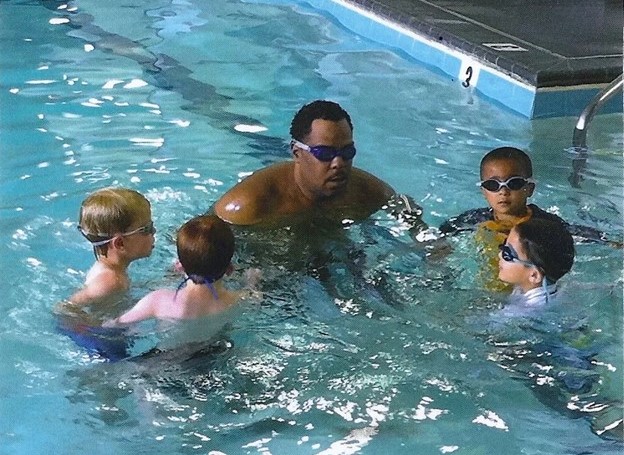By Marie Y. Lemelle
Contributing Writer
With the first day of summer just around the corner and hot temperatures already here, water activities are bound to be high on the list of things to do. But is it safe to go into the water in this COVID-19 era?
While there is no scientific evidence that the coronavirus can be transmitted in a pool, hot tub or water park, the Centers of Disease Control and Prevention offers tips to lower the risk of being infected by the virus when enjoying indoor and outdoor aquatic fun. Recommended tips include to shower and dress in swimwear at home before arriving to the aquatic facility; wear a cloth mask but not in the water; however, bring an additional mask in case it gets wet; and stay six feet apart from others while in any body of water.
“The primary spread in these environments would be by close proximity of individuals, which is often encountered during swim lessons, recreation or exercise activities,” said Bobby Broome, the owner of Bobby Broome Aquatics and author of “The Parent’s Guide To Water Safety And Swim Instruction” and “Learn to Swim In 8 Lessons or Less.”
“COVID-19 has not been detected in chlorinated pool water,” Broome added. “Those chemicals kill most pathogens and it has not been detected in salt water or fresh water.”
It is important to note that outdoor activities are much safer than indoor activities, Broome added. Fully vaccinated individuals have a lowered risk than those who have had one shot or none at all.
The coronavirus is not the only concern when in or near a body of water. The grim statistics as cited by the CDC and other organizations state that there are an estimated 320,000 annual drowning deaths worldwide and drowning is the third leading cause of unintentional injury death worldwide.
Yet, people are hesitant to learn to swim. The American Academy of Pediatrics recommends learning to swim beginning at age 4.
“I learned to swim at the young age of 5,” said Broome, who has American Red Cross certifications and certifies hundreds of lifeguards annually. “I consider myself a YMCA baby because I learned to swim at the YMCA and at 11 years old joined in the Junior Lifeguard program. My first job was a lifeguard at the beach in Chicago on Lake Michigan. Aquatics was always a part of my life’s plan.”
From experience, Broome learned that in general, people hesitate to learn to swim primarily because of fear.
“I breakdown fear into three categories: real, perceived and manufactured,” he said. “Real fear is fear that is learned from parents, caregivers, friends and associations.
“Real fear is learned from bad experiences such as near drowning or simply getting too much water in the nose initially during the learning process,” he said. “Perceived fear is fear of the unknown. Easier to overcome. Manufactured fear is a combination of real fear and complete lack of desire or readiness. The learner convinces themselves to be afraid.”
Aside from acquiring survival skills in the water, Broome says some of the benefits to learn to swim are, “Knowing how to swim makes you less likely to drown in aquatic environments, makes it possible to enjoy leisurely and recreational activities and exercise in aquatic environments, and builds general confidence of one’s ability to overcome fear and to try new things.”
According to the CDC, nearly 4,000 persons in the United States die from drowning annually and drowning is responsible for more deaths among children aged 1–4 years than any other cause except congenital anomalies.
Swimming pool drowning rates among blacks between 5 and 19 is 5.5 times higher than those among whites in the same age group.
Drowning is the cause of death for most boating fatalities. Children younger than 1 are more likely to drown at home or children 5 years old and younger in hot tubs.
“Typically, parents who have no or minimal swimming skills, their children are unlikely to know how to swim,” Broome said. “It is satisfying to see my students learn to swim. For me, it is 10 times more satisfying to watch my students with cognitive disabilities and regular disabilities such as visually impaired or hearing impaired or physically impaired, but cognitive issues such as autism or Down syndrome, become swimmers.”
One of Broome’s best achievements happened when he was hired by parents of a 6-year-old boy who had tactile and autistic issues.
“They wanted their son to enjoy some form of physical activities but he was not able to put anything over his head, not even a shirt. He used to wear button-down shirts because things going over his head would really freak him out,” Broome said. “I was determined to teach him how to swim. Because he would not put his head in the water, I taught how to swim with his head out of the water, which is something I never do.”
Not one to give up, Broome was patient. “It took a long time and over time, he eventually started putting his face in the water and is now a strong swimmer. He still comes to me for swim lessons because I think it is part of his therapy.” The boy is now 17.
“Learning to swim is a great survival skill to master, but I put emphasis on good swimming and water safety habits to prevent an increase in drowning statistics and avoidable water accidents,” Broome said.
Marie Y. Lemelle is the founder of www.platinumstarpr.com and a film producer. She can be reached at MarieLemelle@platinumstarpr.com. Follow her on Instagram @platinumstarpr.












